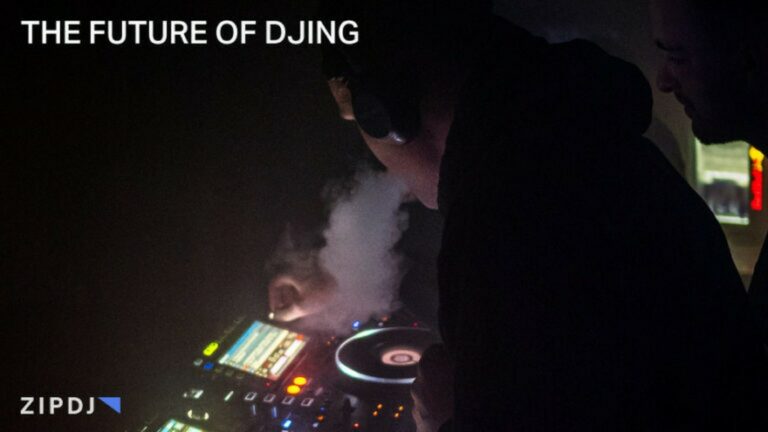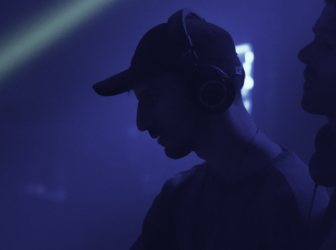The Future Of DJing: Exploring The Next Decade For DJs

The future of DJing has never been more vibrant, with the emergence of artificial intelligence and new DJ controllers reshaping how DJs perform.
As the leading manufacturers of DJ equipment continue to develop new systems, the potential for what DJs can accomplish continues to expand.
In this article, we’ll break down the major emerging trends changing the landscape and blurring the line between DJ and producer.

The Future Of DJing: Exploring The Next Decade For DJs
Over the last few decades, DJ technology has evolved steadily, with little in the way of evolution in terms of how the hardware is used.
But recent advances in touchscreen technology, virtual reality, and artificial intelligence have redesigned how DJs operate.
These developments look set to promise a revolution in DJing that has the capacity to bring unique and creative approaches to mixing.
So, with that said, here are the exciting trends set to change the future of Djing, ranked in order of their potential impact:
10. DJ Friendly Streaming Services
Online music streaming services have greatly impacted how people discover and consume music in recent years.
Spotify, Tidal, and Apple Music, to name some of the big players, have revolutionized the industry with their monthly subscription services.
While music fans have rejoiced at these developments, these streaming services have been notoriously difficult to use for DJing.
There are certain methods you learn to DJ with Spotify, but the broad spectrum of DJing techniques isn’t currently possible.
One of the likely trends we can anticipate is the emergence of DJ-friendly streaming services that can be utilized by club DJs.
This could come in many forms, whether it’s existing streaming services such as Spotify modifying their architecture or a completely new service.
Currently, streaming services can be a massive help for wedding and mobile DJs to fulfill song requests from their audience.
In the future, streaming platforms could allow for techniques such as beat and key matching for dance music and other electronic music genres.
9. A Growing Retro Trend
As technological innovation and increasingly easy-to-use software have democratized DJing, an increasing number are going back to basics.
While the perception that modern DJs simply press play and sit back isn’t true, DJ software featuring beat syncing requires less skill to master.
By contrast, traditional DJing with turntables requires learning how to beat match by ear and is a more tactile method for mixing music.
It’s a more visually interesting method of DJing that has the potential to wow the audience, particularly when combined with scratch DJing and other advanced techniques.
The use of vinyl also opens up new opportunities to discover and mix obscure music that hasn’t made it to online stores where digital music is sold.
Crate digging has long been the preserve of the traditional turntable DJ, and as record sales climb, it will remain a popular niche.
All these trends point to a growth in the number of DJs using vinyl, either in combination with controllers and CDJs or exclusively vinyl.
8. Cloud DJing
One of the most divisive new trends emerging in recent times is the arrival of cloud DJing, with instant access to music libraries.
It’s a technology that is deeply interwoven with some of the best DJ apps, as well as being integrated into professional CDJs.
Pioneer DJ launched their first cloud DJing player in 2011, the CDJ3000, featuring their CloudDirectPlay system.
This system allows users to store their music collection on Dropbox and access them online without requiring a USB stick.
Provided a DJ has a stable and fast internet connection, cloud DJing theoretically allows them to access Beatport’s entire library instantly.
While some established DJs are opposed to the concept and still prefer record stores, cloud DJing could greatly help beginners.
It’s unlikely that there will be a rapid shift away from laptops and USB sticks, but we can expect widespread integration in the future.
Issues around reliability and concerns over data gathering and privacy will need to be ironed out before its broad adoption is guaranteed.
7. Sustainable & Eco-Friendly Festivals
Music festivals have long had a negative image, from complaints about noise pollution to the sight of abandoned tents filling a field.
Event organizers have been working hard to combat this stereotype, hosting sustainable and eco-friendly festivals that respect the environment.
This commitment includes using food sourced locally, deploying low-emission transport, and promoting upcycling of leftover materials.
It also means festivals will increasingly seek renewable energy sources to power the huge lighting rigs and sound systems festivals use.
The 2023 Isle Of Wight festival in the United Kingdom spearheads one such initiative that will change how DJs power their equipment.
Here, turf from the festival site will be sent to a biogas firm and transformed into an impressive 950,000kWh of electricity.
DJs used to using large generators at festival sites may eventually see this as a thing of the past as wind power and other sources become the norm.
6. Collaborative DJing
As DJ culture and music-making increasingly head online collaborative production and DJing will continue to grow in popularity.
DJ collaboration is as old as the art form, with two DJs playing back to back a common sight in nightclubs worldwide.
Transferring this collaborative approach to the digital world has been a long time coming, but low-latency internet connections are making it a reality.
While collaborative DJ apps are in their relative infancy, the technology is already starting to show a great deal of promise.
Applications like Pacemaker allow fellow DJs to collaborate using their iTunes and Spotify music libraries.
This AI-based DJ app delivers a single timeline that overlaps two tracks by simply dragging and dropping each track’s waveform.
Using powerful algorithms, these tracks are automatically quantized while phrasing changes are aligned together.
The inclusion of a “Collaborate” button allows multiple users to work together on a mix in real-time to make edits and add new tracks.
As this and other apps like it continues to evolve, collaborative DJing will likely be embraced by many DJs.

5. Virtual Reality DJ Sets
Virtual reality technology has gotten off to a whimper rather than a bang over the years as developers work to iron out the kinks.
The collapse of Mark Zuckerberg’s Metaverse notwithstanding, virtual reality has nevertheless continued to develop in the DJ world.
Currently, the best DJ visuals still revolve around traditional lights and lasers, with crisp LED screens and the occasional hologram.
The virtual DJ will be able to expand on these visual elements by creating virtual reality environments and dance floors.
There are several companies leading the charge with VR DJ software, for example, TribeXR, which allows DJs to create reactive stages.
This technology allows DJs to invite users to virtual events and converse in real-time with people worldwide.
Virtual attendees can craft their own distinct avatars, while the event’s visuals have the potential to far surpass traditional light shows.
While the virtual reality club attendance is unlikely to surpass real venues any time soon, as a promotional tool, it’s already gaining ground.
4. Touch Screen DJ Controllers
From smartphones and tablets to game consoles such as the Nintendo Switch, touchscreen devices are a ubiquitous aspect of modern technology.
DJ controllers, however, remain largely rooted in the traditional physical buttons, sliders, and knobs found in their latter-day counterparts.
While this could be a reflection of the general preference for the tactile nature of traditional mixers, manufacturers are beginning to embrace touch screens.
As technology improves and touchscreen devices become clearer and more responsive, their viability for DJing increases.
Manufacturers, including Pioneer DJ, Native Instruments, and Denon, have all begun integrating touch screens into their DJ gear.
Touch screens have the potential to open up new DJ techniques, with DJs able to drag, expand, and manipulate sounds in new ways.
The limitations of sliders and knobs in traditional DJ controllers could become a thing of the past as touchscreen devices take over.
For now, these manufacturers have retained the familiar physical jog wheel, pitch fader, and general functionality buttons.
But as startups such as Touch Innovation develops touchscreen-only DJ interfaces, it’s likely the big players will start to follow suit.
3. Live Remixing
With a vast archive of music available online that anyone can access, standing out from the DJing crowd is increasingly challenging.
The advent of live remixing opens up new opportunities for DJs to flex their creative skills in live sets with on-the-fly remixes.
Native Instruments has led the charge with live remixing software, introducing rapid editing tools with Traktor Remix Decks.
Smaller companies have followed suit, such as the Remixlive application from Mixvibes, available on the Play Store.
These applications allow DJs to introduce synced loops and samples that can be manipulated in real-time during their sets.
The possibilities offered by live remixing technology allow for open-ended manipulation of one track to create entirely new sounds.
For example, DJs can simply sign up for a record pool and instantly remix the latest song and seamlessly integrate it into their sets.
The technique will blur the line between DJing and music production, allowing them to easily modify someone else’s music on the fly.
Blurring the line between DJing and production, live remixing could pave the way for a new generation of music composition-savvy DJs.
2. Augmented Reality DJ Software
While the potential for touchscreen DJ interfaces suggests exciting new possibilities, augmented reality is on a whole new level.
While augmented reality technology has yet to break into the mainstream, there are already fascinating developments for DJ software.
Microsoft’s HoloLens 2 headset successfully overlays applications onto the real world, allowing users to manipulate them by hand.
Some industry analysts believe this technology will surpass VR by removing the need for cumbersome headsets.
Over time, we could see an entire archive of hardware and DJing tools modeled and represented in augmented reality programs.
CDJ controllers, turntables, and even synthesizers and other production hardware could all be interfaced using augmented reality.
By viewing these interfaces in the context of the real world, DJs can maintain their interaction with the crowd, a vital aspect of club culture.
The advent of augmented reality DJ software represents another evolution of the tools redefining how DJs play live in the modern era.
1. Artificial Intelligence
The role of artificial intelligence in music is another trend that is evolving rapidly and changing the way DJs work.
AI is already playing a role in DJing, with companies such as Algoriddim and DJUCED using algorithms to automate mixing.
With DJs free from finding cue points, beat matching, and key syncing, they can focus on more creative mixing processes.
This technology has the ability to turn bad DJs into good DJs, much like AI-powered tools for writing can iron out the flaws in poorly-written articles.
AI-powered tools can also help to isolate specific track elements such as percussion, vocals, and basslines.
These elements can then be looped and put through various editing effects to create fresh sounds to bring back into the DJ set.
The possibilities artificial intelligence offers are limitless and will impact everything from scratch DJing to live remixing.
As technology continues to evolve at an unprecedented pace, the future of DJing could be set to experience more profound changes.
Summary
The future of DJing will continue to bring new technology to a wider audience as trends around artificial intelligence and virtual reality continue.
With DJ gear evolving to keep up with these technological developments, the nature of DJing and performance will likely see different styles emerge.
With machine learning developing at an unprecedented pace, the possibilities for what new technology lies ahead remain to be seen.
Build your music library by signing up for ZIPDJ and gain access to all the latest hits and remixes.
Not a member ?
Join Today for Unlimited Music Downloads. Visit zipdj.com for more information.



